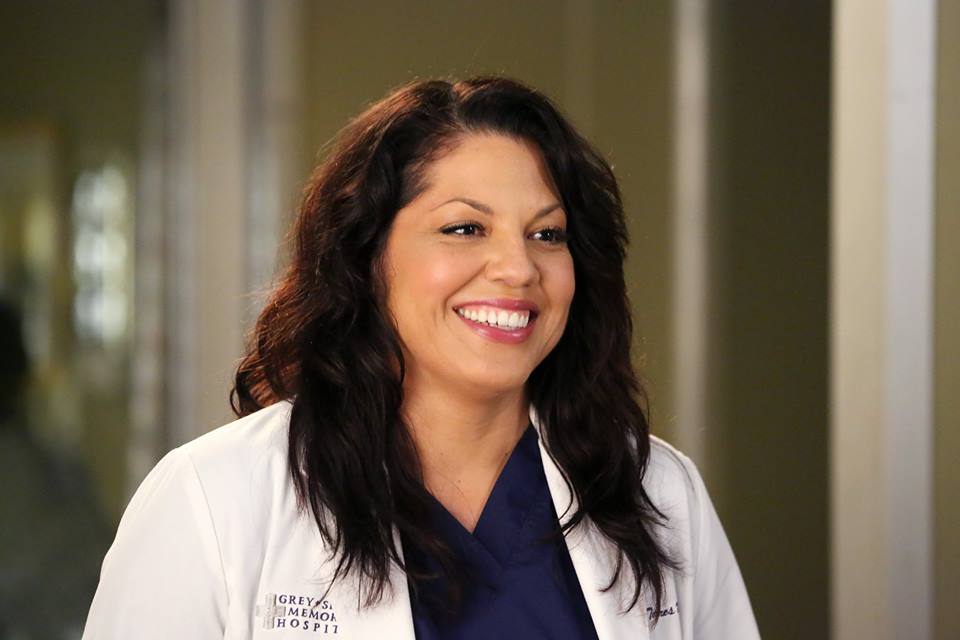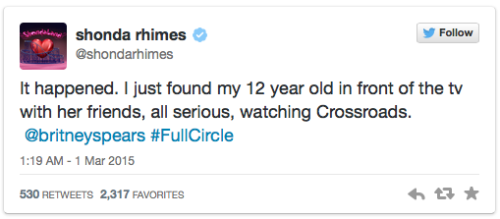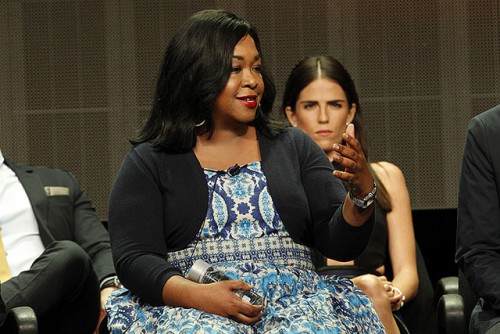This guest post written by Cheyenne Matthews-Hoffman appears as part of our theme week on Bisexual Representation.
It’s no secret that bisexual characters are lacking on television. Even as queerness becomes more prevalent on-screen, the roles are sparse and often times showcase harmful generalizations and stereotypes. Shonda Rhimes’ television empire Shondaland is a powerful part of the changing landscape of entertainment. Her portrayal of people of color, women, and queer characters is nuanced and intricate. She doesn’t discriminate when it comes to drama and thrills; everyone is subject to the emotional roller coaster that is TGIT, no matter who they are.
Her portrayal of LGBTQ characters has been heralded by GLAAD, the most recent accolades coming from the inclusion of How to Get Away with Murder’s protagonist Annalise Keating’s bisexuality. And while the revelation resonated on social media in the weeks afterward, becoming yet another notch in the lineup’s belt of diversity, the best bisexual character lives in another corner of Shondaland.
The groundbreaking story of Dr. Calliope “Callie” Torres on Grey’s Anatomy has been one of the greatest journeys on television. Callie (Sara Ramirez) made her way into the OR in late season 2 in 2006 as a love interest for George O’Malley (T. R. Knight). One tumultuous relationship rocked by typical Grey’s Anatomy drama and an elopement later, the couple broke up. Later in season 4, Callie began realizing she was attracted to cardio surgeon Erica Hahn (Brooke Smith).
In 2008, Don’t Ask Don’t Tell was still in effect. Washington expanded its domestic partnership legislation and the California Supreme Court struck down the same-sex marriage ban, but states like Arizona and Florida passed amendments prohibiting it. On television, depictions of LGBTQ characters were incredibly sparse. Will & Grace was over, with The L Word soon to follow, and shows like Glee and Modern Family were more than a year away from premiering. GLAAD reported LGBT representation on scripted broadcast television that year at a measly 1.1%. Against a backdrop of a television landscape lacking in queer representation (especially queer women of color) emerged Callie Torres’ anxious and exciting adventure of self-discovery.
The trepidation Callie had about her budding feelings for her friend were clear, and oh so relatable to anyone discovering their own sexuality. She skirted around asking for advice on dating women from her friends and peers. She reverted to sleeping with her friend-with-benefits Mark Sloan (Eric Dane), in an effort to convince herself she was straight. And after having sex with Erica, she became even more confused because she couldn’t decide if she preferred sex with men or women better, ultimately coming to the conclusion that she likes both. Being dumped by her first girlfriend hurt her just as much as divorcing her first husband. The added sting of Erica telling her she “can’t kind of be a lesbian” tapped into the very real biphobia that bisexual people face from inside the LGBTQ community. Between the drama of stealing organs and patients dying of the hiccups, moments crafted around Callie’s sexuality often encapsulated incredibly genuine experiences.
Callie’s subsequent relationship with Arizona Robbins (Jessica Capshaw) quickly made them one of the most popular power couples in the show. Their drama ranged from silly to heartbreaking, just like the straight couples. They were given growth and hardship equitable to everyone else. The only way the relationship differed from the rest on the show were the storylines dealing explicitly with their sexuality. Arizona was sometimes insecure of Callie’s bisexuality, even going so far as to use it against her in the more heated moments of fights. Callie coming out to her father and being exiled by her family was an all too real display of the experiences many queer people have and fear. Her refusal to back down against her father, her iconic “you can’t pray away the gay” speech strengthened the resolve Callie had inside of her sexuality and affirmed to the audience that it was very real. Her emotional breakdown after the falling out with her family painted her as such a tangible, authentic character. Not only did the TV series depict the tough ortho surgeon as resolute and confident in her bisexuality, it showed her devastation when the people she loved didn’t approve of her.
The season 7 storyline regarding Callie getting pregnant by Mark after she and Arizona break up only to reconcile, and the ensuing decision to co-parent the child was criticized when it aired. Some felt the storyline stereotyped bisexuality and watered down the importance of Callie and Arizona’s relationship. Arizona even somewhat lampshaded the situation in an argument, saying it’s “some kind of bi dream come true… you get the woman that you love and the guy best friend who’s also a great lay,” in season 7, episode 16. It was hardly writer negligence, however. Mark had already been established as a thorn in Arizona’s side and an unwanted addition in her relationship; an annoying best friend to those he befriended. Callie sleeping with Mark after the break-up was a common situation we see in TV: characters hooking up with someone else to escape the pain of being dumped. It further served to show that Callie’s relationship with a woman didn’t negate her bisexuality or attraction to men. While convoluted and ridiculous, the The Kids Are Alright-esque plotline didn’t stray from the generally ridiculous Shondaland stories we’ve come to know and love (or hate).
Callie’s bisexuality is important because it never became stigmatized. She isn’t painted as a cheater or overtly sexual or greedy — common harmful tropes about bisexual people. She had the acceptance of her peers and the support of her friends and coworkers. While it took some time for her father to come around to acceptance, and the series made it clear that her mother never would, there existed a dichotomy of how sexuality is perceived, even within the same immediate family. Callie faced “normal” problems in her personal and professional life. Her relationships contained exciting highs and depressing lows. She was allowed to be vulnerable, even though she broke bones for a living. Callie Torres is a fully fleshed out resilient, sensitive, complex, and unapologetic bisexual Latina woman.
Callie’s story and the showcasing of her ability to enter into emotionally deep and complex relationships with both men and women is commendable. Her discovery that she’s attracted to women as an adult gives representation to people who also had latent realizations about their sexuality. Her relationship drama was just as heartbreaking and intense as the other couples on the show. Grey’s Anatomy and actor Sara Ramirez did an outstanding job at telling this story over the course of a decade.
In real life, Sara Ramirez is a prominent advocate for the LGBTQ community; she’s on the board of True Colors Fund, a nonprofit that aims to eradicate LGBTQ youth homelessness. In 2015, the Human Rights Campaign honored her with the Ally for Equity award. Just check out her Twitter feed and you’ll see how serious Ramirez is about supporting queer communities. Witnessing this real-life advocacy juxtaposed with how fantastic her Grey’s Anatomy character is written and portrayed is just the cherry on top.
Although Dr. Callie Torres may not be scrubbing into Grey Sloan Memorial anymore, the legacy she left at the hospital, and on television as a whole, is insurmountable. Her story was groundbreaking at its inception and continued breaking barriers as the years went on. She wasn’t afraid to own her bisexuality, reminding us that the B in LGBTQ didn’t just stand for “badass.” She managed to incite real change both on and off-screen. After Callie came out, more than 200 other lesbian and bisexual characters were introduced on TV. Callie’s journey was an iconic one that helped to not only change television, but to cement the oft forgotten notion that bisexuality is very real.
Update on 10/20/16: Ramirez’s connection to the orthopedic surgeon she played is bone deep; the actress publicly came out as bisexual on October 8th at the True Colors Fund’s 40 to None Summit. In a speech on ending LGBT youth homelessness, she stressed the importance of recognizing intersectionality and mentioned her own intersections, including bisexual and queer, as reasons why she is invested in the cause.
See also at Bitch Flicks:
Interracial Relationships on Grey’s Anatomy
Being in the Sun — Women and Power in Grey’s Anatomy Season 11
Cheyenne Matthews-Hoffman is a freelance entertainment writer and digital content manager who is obsessed with an absurd amount of television shows. She is an advocate for accessible entertainment and sometimes develops websites. You can find her at @heycheyennehey on Twitter or cheyennecheyenne.com.


























